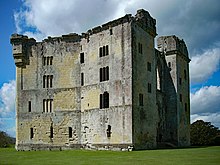Henry Arundell, 3rd Baron Arundell of Wardour
Henry Arundell, 3rd Baron Arundell of Wardour | |
|---|---|
| Born | 23 February 1607/8 |
| Died | 28 December 1694 |
| Occupation | Peer of England |
Henry Arundell, 3rd Baron Arundell of Wardour,
Early life
He was baptised on 23 February 1607/8 at

Career
| Henry Lord Arundell of Wardour (Restoration of Estate) Act 1660 | |
|---|---|
| Act of Parliament | |
 12 Cha. 2. c. 16 | |
| Dates | |
| Royal assent | 29 December 1660 |
On 13 May 1652 he acted as one of the seconds of his brother-in-law
In January 1669 he was summoned by

Popish Plot
In 1678
The charges were patently absurd: among other unlikely accusations, Arundell was alleged to have conspired with his fellow Catholic peer, William Howard, 1st Viscount Stafford (who was executed in 1680 for his supposed part in the Plot), although it was common knowledge that following a bitter quarrel they had not spoken to each other for some 25 years. Far from having any motive to kill the King, both were well aware of how much they had gained from his policy of religious tolerance. As Stafford sensibly remarked, simple self-interest dictated that the Catholic peerage should remain loyal to Charles ll, who in his later years was an all but open Catholic himself, whereby: "we have no interest but to be quiet". Arundell was friendly with Lord Belasyse, who like Arundell suffered a term of imprisonment as a supposed Plotter, and with the civil servant Edward Colman, an ardent Catholic who was executed for his supposed part in the Plot in December 1678, but there is no reason to think that there was anything sinister about these friendships. During his imprisonment in 1679, Arundell wrote five short religious poems, published in a single folio sheet in 1679, and reissued in A Collection of Eighty-six Loyal Poems in 1685.[1]
Later years
After the death of Charles II, his successor, James II, admitted Arundell, although he was a Roman Catholic, to the
After the deposition of King James II, Arundell retired to his house at Breamore, Hampshire, and took no further part in public life. He died at Breamore on 28 December 1694, at the age of eighty-eight. He was buried with his ancestors at Tisbury, Wiltshire. He was a noted gambler and sportsman, and kept at Breamore a celebrated pack of hounds, which became the property of the Earl of Castlehaven, and subsequently of Hugo Meynell. From them, the Quorn Hunt's pack is descended.[1]
Family
He was the only son of

He married Cicely Compton (c. 1610 – 24 March 1675/76), daughter of the Hon. Sir Henry Compton, Knt., of Brambletye, Sussex, invested as a Knight of the Order of the Bath (KB) on 25 July 1603, and his first wife Lady Cicely Sackville, and widow of Sir John Fermor. She was a granddaughter of Sir Henry Compton, 1st Baron Compton and of Robert Sackville, 2nd Earl of Dorset through her mother (herself a half-sister of Richard Sackville, 3rd Earl of Dorset and Edward Sackville, 4th Earl of Dorset). Her stepmother was Mary Browne, daughter of Sir George Browne, also a widow, of Thomas Paston, of Thorpe, Surrey.
Their children were:
- Thomas Arundell, 4th Baron Arundell of Wardour, b. 1633, d. 10 Feb 1711/12[3] He became the fourth Lord Arundell of Wardour, and was in the retinue of Roger Palmer, 1st Earl of Castlemaine on his visit to Pope Innocent XI as James II's ambassador.
- Hon. Henry Arundell. A settlement for the marriage between him and Mary Scrope [4] was made on 10 February 1675. They had no issue.
- Hon. Cicely Arundell, d. 1717, a nun at Rouen, Caux, France. She entered the order of Poor Clares of Rouen in 1662, and died at Rouen on 13 June 1717, at the age of eighty-two.
Ancestry
| Henry Arundell, 3rd Baron Arundell of Wardour | Father: Thomas Arundell, 2nd Baron Arundell of Wardour |
Paternal Grandfather: Thomas Arundell, 1st Baron Arundell of Wardour |
Paternal Great-grandfather: Sir Matthew Arundell, of Wardour Castle |
| Paternal Great-grandmother: Margaret Willoughby | |||
| Paternal Grandmother: Mary Wriothesley, Baroness Arundell of Wardour
|
Paternal Great-grandfather: Henry Wriothesley, 2nd Earl of Southampton | ||
| Paternal Great-grandmother: Mary Browne | |||
| Mother: Blanche Somerset, Baroness Arundell of Wardour |
Maternal Grandfather: Edward Somerset, 4th Earl of Worcester |
Maternal Great-grandfather: William Somerset, 3rd Earl of Worcester | |
| Maternal Great-grandmother: Christian North | |||
| Maternal Grandmother: Elizabeth Hastings
|
Maternal Great-grandfather: Francis Hastings, 2nd Earl of Huntingdon | ||
| Maternal Great-grandmother: Catherine Pole
|
Notes
- ^ a b c d e s:Arundell, Henry, third Baron Arundell of Wardour (DNB00)
- trial of the five Catholic lords
- ^ Predecessor of the seventh and eighth Earls of Castlehaven, and the nineteenth Lord Audley.
- ^ Wright, John Michael. "Mary Scrope, the Honourable Mrs Henry Arundell". Art UK.
References
- Attribution
![]() This article incorporates text from a publication now in the public domain: "Arundell, Henry". Dictionary of National Biography. London: Smith, Elder & Co. 1885–1900.
This article incorporates text from a publication now in the public domain: "Arundell, Henry". Dictionary of National Biography. London: Smith, Elder & Co. 1885–1900.
External links
- The Wikisource article about his grandfather cited here also describes his biography.
 Grey, Francis W. (1913). "Arundell". In Herbermann, Charles (ed.). Catholic Encyclopedia. New York: Robert Appleton Company. Article on the first, second and third Lords Arundell of Wardour
Grey, Francis W. (1913). "Arundell". In Herbermann, Charles (ed.). Catholic Encyclopedia. New York: Robert Appleton Company. Article on the first, second and third Lords Arundell of Wardour- The third Baron Arundell of Wardour at thepeerage.com
